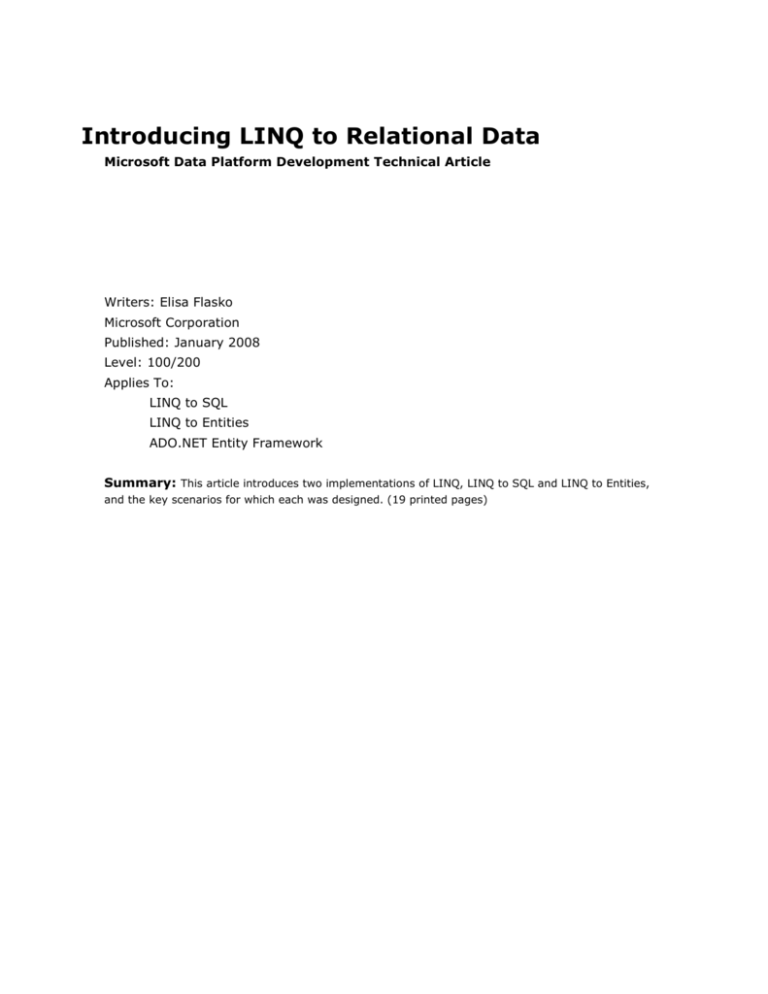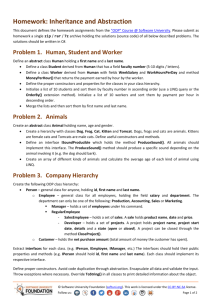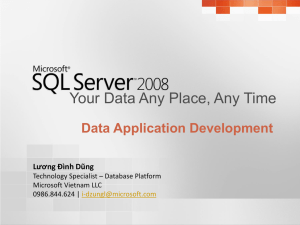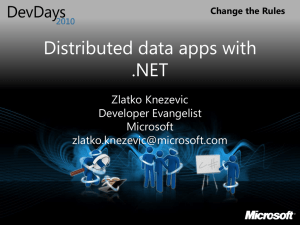
Introducing LINQ to Relational Data
Microsoft Data Platform Development Technical Article
Writers: Elisa Flasko
Microsoft Corporation
Published: January 2008
Level: 100/200
Applies To:
LINQ to SQL
LINQ to Entities
ADO.NET Entity Framework
Summary: This article introduces two implementations of LINQ, LINQ to SQL and LINQ to Entities,
and the key scenarios for which each was designed. (19 printed pages)
Copyright
This is a preliminary document and may be changed prior to final commercial release of any of the software
described herein.
The information contained in this document represents the current view of Microsoft Corporation on the issues
discussed as of the date of publication. Because Microsoft must respond to changing market conditions, it
should not be interpreted to be a commitment on the part of Microsoft, and Microsoft cannot guarantee the
accuracy of any information presented after the date of publication.
This White Paper is for informational purposes only. MICROSOFT MAKES NO WARRANTIES, EXPRESS,
IMPLIED OR STATUTORY, AS TO THE INFORMATION IN THIS DOCUMENT.
Complying with all applicable copyright laws is the responsibility of the user. Without limiting the rights under
copyright, no part of this document may be reproduced, stored in or introduced into a retrieval system, or
transmitted in any form or by any means (electronic, mechanical, photocopying, recording, or otherwise), or
for any purpose, without the express written permission of Microsoft Corporation.
Microsoft may have patents, patent applications, trademarks, copyrights, or other intellectual property rights
covering subject matter in this document. Except as expressly provided in any written license agreement
from Microsoft, the furnishing of this document does not give you any license to these patents, trademarks,
copyrights, or other intellectual property.
Unless otherwise noted, the example companies, organizations, products, domain names, e-mail addresses,
logos, people, places and events depicted herein are fictitious, and no association with any real company,
organization, product, domain name, email address, logo, person, place or event is intended or should be
inferred.
2008 Microsoft Corporation. All rights reserved.
Microsoft, .NET Framework, SQL Server, Visual Studio, and Windows are either registered trademarks or
trademarks of Microsoft Corporation in the United States and/or other countries.
The names of actual companies and products mentioned herein may be the trademarks of their respective
owners.
Table of Contents
Introducing LINQ to Relational Data .................................................................1
What Is LINQ to SQL? .......................................................................................1
When Do I Use LINQ to SQL? ............................................................................ 6
What Is LINQ to Entities? ..................................................................................7
When do I use LINQ to Entities? ...................................................................... 12
Conclusion.......................................................................................................13
Introducing LINQ to Relational Data
1
Introducing LINQ to Relational Data
With the combined launch of Visual Studio 2008, SQL Server 2008, and Windows Server
2008, Microsoft is introducing five implementations of .NET Language Integrated Query
(LINQ).
Of these five implementations, two specifically target access to relational databases:
LINQ to SQL and LINQ to Entities. This white paper introduces these two technologies
and the scenarios in which each can best be used.
Microsoft Language Integrated Query (LINQ) offers developers a new way to query data
using strongly-typed queries and strongly-typed results, common across a number of
disparate data types including relational databases, .NET objects, and XML. By using
strongly-typed queries and results, LINQ improves developer productivity with the
benefits of IntelliSense and compile-time error checking.
LINQ to SQL, released with the Visual Studio 2008, is designed to provide
strongly-typed LINQ access for rapidly developed applications across the
Microsoft SQL Server family of databases.
LINQ to Entities, to be released in an update to Visual Studio 2008 in the first
half of 2008, is designed to provide strongly-typed LINQ access for
applications requiring a more flexible Object Relational mapping, across
Microsoft SQL Server and third-party databases.
What Is LINQ to SQL?
LINQ to SQL is an object-relational mapping (ORM) framework that allows the direct 11 mapping of a Microsoft SQL Server database to .NET classes, and query of the
resulting objects using LINQ. More specifically, LINQ to SQL has been developed to
target a rapid development scenario against Microsoft SQL Server where the database
closely resembles the application object model and the primary concern is increased
developer productivity.
Figures 1 & 2 combined with the code snippet below demonstrate a simple LINQ to SQL
scenario. Figure 1 shows the LINQ to SQL mapping, and Figure 2 shows the associated
database diagram, using the Northwind database.
Microsoft Corporation ©2008
Introducing LINQ to Relational Data
2
Figure 1. Database diagram for a subset of the Northwind database.
Figure 2. LINQ to SQL mapping diagram for a simple scenario using a subset of
the Northwind database and the associated database diagram. Notice the use
of an intermediary table to map the many-to-many relationship between
Employees and Territories.
Microsoft Corporation ©2008
Introducing LINQ to Relational Data
3
This code snippet shows a simple LINQ query against the Northwind database to
retrieve all customers whose address is in London.
NorthwindDataContext db = new NorthwindDataContext();
var customers = from c in db.Customers
where c.City == "London"
select c;
Listing 1. Simple LINQ to SQL query
LINQ to SQL has been architected with simplicity and developer productivity in mind.
APIs have been designed to “just work” for common application scenarios. Examples of
this design include the ability to replace unfriendly database naming conventions with
friendly names, to map SQL schema objects directly to classes in the application, to
implicitly load data that has been requested but has not previously been loaded into
memory, and the use of common naming conventions and partial methods to provide
custom business or update logic.
The ability to replace unfriendly database naming conventions with more developer
friendly names provides benefit that is pretty self explanatory, making it easier to
understand the structure and meaning of data as the application is developed. These
changes can be done using the LINQ to SQL designer in Visual Studio 2008, by double
clicking on the entity object name, as seen in Figure 3 below.
Figure 3. Changing the name of an entity object in LINQ to SQL.
As mentioned above, LINQ to SQL targets scenarios where the database closely
resembles the application object model that is desired. Given this target scenario, the
mapping between the SQL schema and classes in the application is a direct 1-1
mapping, meaning that a table or view being accessed from the database maps to a
single class in the application, and a column being accessed maps to a property on the
associated class.
By default, LINQ to SQL enables deferred loading. This means that if, for example, a
query retrieves Customer data, it does not automatically pull the associated Order
information into memory. When the data is requested however, LINQ to SQL uses its
implicit loading capability to retrieve the data that has been requested but has not
previously been loaded into memory. In Listing 1 we queried the database for all
customers with an address based in London. While iterating through the resulting list of
customers we would like to access the list of Orders that each customer has placed.
Looking back to the original query in Listing 1, we notice that we did not retrieve any
information about Orders; we simply retrieved information included in the Customer
object. In Listing 2, we continue from the previous query to iterate through the
Microsoft Corporation ©2008
Introducing LINQ to Relational Data
4
customers that were returned and print out the total number Orders associated with
each customer.
foreach (Customer c in customers)
{
Console.WriteLine(c.CompanyName + " " + c.Orders.Count);
}
Listing 2. Implicit loading of Orders data that has been requested but not
previously loaded into memory.
In the above example, a separate query is executed to retrieve the Orders for each
Customer. If it is known in advance that we need to retrieve the orders for all
customers, we can use LoadOptions to request that the associated Orders be retrieved
along with the Customers, in a single request.
Beyond the simplicity of the query experience, LINQ to SQL offers additional features to
improve the developer experience with regards to application logic. Partial methods, a
new language feature of C# and VB in Visual Studio 2008, allow one part of a partial
class to define and call methods which are invoked, if implemented in another part of
the class. If the method has not been implemented; the entire method call is optimized
away during compilation. By using common naming conventions in conjunction with
these new partial methods and partial classes, introduced in Visual Studio 2005, LINQ
to SQL allows application developers to provide custom business logic when using
generated code. Using partial classes allows developers the flexibility to add methods,
non-persistent members, etc., to the generated LINQ to SQL object classes. These
partial methods can add logic for insert, update, and delete by simply implementing the
associated partial method. Similarly, developers can use the same concepts to
implement partial methods that hook up eventing in the most common scenarios, for
example OnValidate, OnStatusChanging or OnStatusChanged. Example 3 shows the
use of partial methods to implement custom validation on the Customer Phone property
as it is changed.
public partial class Customer
{
partial void OnPhoneChanging(string value)
{
Regex phoneNum = new Regex(@"^[2-9]\d{2}-\d{3}-\d{4}$");
if (phoneNum.IsMatch(value) == false)
throw new Exception("Please enter a valid Phone Number");
}
}
Listing 3. Use of partial methods to implement custom validation logic.
Once developers can leverage the query capabilities of LINQ and implement business
logic in partial methods, the argument for using persistent objects becomes quite
compelling. To round the story out, LINQ to SQL allows people to model inheritance
hierarchies in their classes and map them to the database. Inheritance, an important
feature of object-oriented programming, does not translate directly into the relational
database; therefore, the ability to map inheritance from the application into the
database is very important. LINQ to SQL supports one of the most common database
Microsoft Corporation ©2008
Introducing LINQ to Relational Data
5
inheritance mappings, Table per Hierarchy (TPH), where multiple classes in a hierarchy
are mapped to a single table, view, stored procedure, or table valued function using a
discriminator column to determine the specific type of each row/instance. In Figure 4, a
single Product table in the database, maps the inheritance of DiscontinuedProduct from
Product. This two-class hierarchy is mapped directly to the existing Northwind database
using the discriminator column “Discontinued”.
Figure 4. Inheritance in LINQ to SQL
Notice that the properties of the inheritance (right-click on the relationship arrow)
specify the discriminatory property and the associated discriminator values, while the
properties of DiscontinuedProduct specify the base class from which it inherits.
LINQ to SQL has been developed with a minimally intrusive object model, allowing
developers to choose whether or not to make use of generated code. Rather, they can
create their own classes, which do not need to be derived from any specific base class.
This means that you can create classes that inherit from no base class or from a custom
base class.
As with any application framework, developers must also have the ability to optimize
the solution to best fit their scenario. LINQ to SQL offers a number of opportunities to
optimize, including using load options to control database trips and compiled queries to
amortize the overhead inherent in SQL generation. By default, LINQ to SQL enables
Object Tracking, which controls the automatic change tracking and identity
management of objects retrieved from the database. In some scenarios, specifically
Microsoft Corporation ©2008
Introducing LINQ to Relational Data
6
where you are accessing the data in a read-only manner, you may wish to disable
Object Tracking as a performance optimization. The options for specialization of your
application behavior is not local to just the API, the LINQ to SQL Designer also allows
additional functionality for you to expose stored procedures and/or table valued
functions as strongly typed methods on the generated DataContext, and map inserts,
updates, and deletes to stored procedures if you choose not to use dynamic SQL.
Developers who are concerned about query performance can leverage the compiled
queries capabilities which offer an opportunity to optimize query performance. In many
applications you might have code that repeatedly executes the same query, possibly
with different argument values. By default, LINQ to SQL parses the language expression
each time to build the corresponding SQL statement, regardless of whether that
expression has been seen previously. Compiled queries, like that seen in Listing 4, allow
LINQ to SQL to avoid reparsing the expression and regenerating the SQL statement for
each repeated query.
var customers = CompiledQuery.Compile(
(NorthwindDataContext context,
string filterCountry) =>
from c in context.Customers
where c.Orders.Count > 5
select c);
NorthwindDataContext db = new NorthwindDataContext();
Console.WriteLine("Customers in the USA: ");
foreach (var row in customers(db, "USA"))
{
Console.WriteLine(row.CompanyName);
}
Console.WriteLine();
Console.WriteLine("Customers in Spain: ");
foreach (var row in customers(db, "Spain"))
{
Console.WriteLine(row.CompanyName);
}
Listing 4. An example of a simple compiled query, executed twice with varying
parameters.
When Do I Use LINQ to SQL?
The primary scenario for using LINQ to SQL is when building applications with a rapid
development cycle and a simple one-to-one object to relational mapping against the
Microsoft SQL Server family of databases. In other words, when building an application
whose object model is structured very similarly to the existing database structure, or
when a database for the application does not yet exist and there is no predisposition
against creating a database schema that mirrors the object model; you can use LINQ to
SQL to map a subset of tables directly to classes, with the required columns from each
Microsoft Corporation ©2008
Introducing LINQ to Relational Data
7
table represented as properties on the corresponding class. Usually in these scenarios,
the database has not and/or will not be heavily normalized.
I want to…
LINQ to SQL is
applicable
Use an ORM solution and my database is 1:1 with my object
model
Use an ORM solution with inheritance hierarchies that are
stored in a single table
Use my own plain CLR classes instead of using generated
classes or deriving from a base class or implementing an
interface
Leverage LINQ as the way I write queries
Use an ORM but I want something that is very performant
and where I can optimize performance through stored
procedures and compiled queries
Table 1. LINQ to SQL Scenarios
What Is LINQ to Entities?
LINQ to Entities, like LINQ to SQL is a LINQ implementation providing access to
relational data, but with some key differences.
LINQ to Entities is, specifically, a part of the ADO.NET Entity Framework which allows
LINQ query capabilities. The Entity Framework is the evolution of ADO.NET that allows
developers to program in terms of the standard ADO.NET abstraction or in terms of
persistent objects (ORM) and is built upon the standard ADO.NET Provider model which
allows access to third party databases. The Entity Framework introduces a new set of
services around the Entity Data Model (EDM) (a medium for defining domain models for
an application). This set of services includes the following:
Domain Modeling Capabilities and the ability to define conceptual, data store
agnostic models
Object Relational Mapping Capabilities (full CRUD and state management
scenarios)
Database independent Query Capabilities using LINQ or Entity SQL
More than a simple Object Relational Mapping (ORM) tool, the ADO.NET Entity
Framework and LINQ to Entities allow developers to work against a conceptual model
with a very flexible mapping and the ability to accommodate a high degree of
divergence from the underlying data store. For further discussion of the Entity
Framework and EDM, please see the Data Platform Development Center
(http://msdn.microsoft.com/data).
Figure 5 below shows a simple LINQ to Entities EDM diagram, using the same subset of
the Northwind database seen in Figure 1.
Microsoft Corporation ©2008
Introducing LINQ to Relational Data
8
Figure 5. LINQ to Entities mapping diagram corresponding to the Northwind
database subset in Figure 1. Notice the directly mapped many-to-many
relationship between Employees and Territories without an intermediary table.
In this figure you can see that the object model is not mapped directly, one-to-one, to
the database, rather we have bypassed the intermediary table used to represent the
many-to-many relationship between Employees and Territories. Although you can map
many-to-many relationships in both LINQ to SQL and LINQ to Entities, LINQ to Entities
allows a direct mapping of many-to-many relationships with no intermediary class,
while LINQ to SQL requires that an intermediary class map one-to-many to each of the
classes that are party to the many-to-many relationship.
Listing 5 below shows the same simple LINQ query used in Listing 1 for LINQ to SQL,
used against the Entity Data Model shown in Figure 5.
using (NorthwindEntities nw = new NorthwindEntities())
{
var cusotmers = from c in nw.Customers
where c.City == "London"
select c;
}
Listing 5. Simple LINQ to Entities query
The similarities between the two LINQ implementations for this simple query highlight
the benefit of LINQ creating a query language that remains consistent across data
stores.
Microsoft designed the ADO.NET Entity Framework, and in turn LINQ to Entities, to
enable flexible and more complex mappings, ideal in the scenario where it is not
possible or ideal for the object model to match the database schema. The mapping
flexibility available with the ADO.NET Entity Framework allows the database and
application(s) to evolve separately and makes development against highly normalized
databases simpler and easier to understand. When a change is made in the database
Microsoft Corporation ©2008
Introducing LINQ to Relational Data
9
schema, the application is insulated from the change by the Entity Framework, and
there is no requirement to rewrite portions of the application, but rather the mapping
files can simply be updated to accommodate the database change. In Figures 6 & 7, a
change is made to the database splitting the Employees table to separate personal
information that is only accessible to HR and information that is available in the
Employee Address Book. If existing applications are not going to make use of these
changes we simply need to update the mapping to account for this change.
Figure 6. Database Model for the new modified Northwind database subset. In
this modified database, we have split the Employees table into two tables one
containing Employee information that is only available to HR and another
containing information that is available to all employees in the Employee
Address Book. We have also used a different inheritance mapping, Table per
Subclass, which we will discuss later.
Microsoft Corporation ©2008
Introducing LINQ to Relational Data
10
Figure 7. Entity Data Model Diagram for the modified Northwind database
subset shown in Figure 6.
Listing 6 shows a query against a single entity, mapped to multiple tables in the
database. The same query directly against the database would require the
knowledge that Employee information is split between two tables and a join of
those two tables in the query.
using (NorthwindModEntities nw = new NorthwindModEntities())
{
var q = from e in nw.Employees
select e;
foreach (Employees emp in q)
{
Console.WriteLine(emp.FirstName + ", " + emp.LastName + ",
Hire Date: " + emp.HireDate.ToString());
}
}
Listing 6. Querying a single Entity mapped to two tables in the database.
As discussed earlier in this article, LINQ to SQL allows one of the most common
inheritance scenarios to be mapped, Table per Hierarchy. LINQ to Entities and the
ADO.NET Entity Framework also allow the mapping of two other types of inheritance. In
addition to Table per Hierarchy (as supported by LINQ to SQL), the Entity Framework
supports:
Microsoft Corporation ©2008
Introducing LINQ to Relational Data
11
The mapping of Table per Concrete Type, a separate table for each class or type
in the hierarchy.
The mapping of Table per Subclass, a hybrid approach using a shared table for
information about the base type and separate tables for information about the
derived types seen in Figure 8.
Figure 8. Mapping Table per Subclass inheritance with the Entity Data Model.
Similar to LINQ to SQL, LINQ to Entities uses partial classes and partial methods to
allow update and business logic to be easily added to generated code. Using partial
classes and partial methods allows developers the flexibility to add methods, nonpersistent members, etc., to the generated Entity Framework object classes, and for
the addition of custom logic for insert, update, and delete by simply implementing the
associated partial method. Similarly, developers can use the same concepts to
implement partial methods that hook up eventing in the most common scenarios, for
example OnStatusChanging or OnStatusChanged. Listing 7 shows the use of partial
methods to implement custom validation on the Customer Phone property as it is
changed.
public partial class Customers
{
partial void OnPhoneChanging(string value)
{
Regex phoneNum = new Regex(@"^[2-9]\d{2}-\d{3}-\d{4}$");
if (phoneNum.IsMatch(value) == false)
throw new Exception("Please enter a valid Phone Number");
}
}
Microsoft Corporation ©2008
Introducing LINQ to Relational Data
12
Listing 7. Use of partial methods to implement custom validation logic.
Due to the explicit nature of LINQ to Entities, developers also have the ability to
optimize the solution to best fit their scenario. In Listing 2 for LINQ to SQL, when we
queried for Customer data, Order information was not automatically pulled into
memory, but rather was only pulled into memory only when the Order information was
accessed. In LINQ to Entities, the developer has full control over the number of
database round trips by explicitly specifying when to load such information from the
database. Navigating to associated information that has not yet been retrieved from the
database will not cause an additional database trip, but rather will only return the
information if it was explicitly requested with the first query or with a new query, as
seen in Listing 8.
using (NorthwindModEntities nw = new NorthwindModEntities())
{
var q = from cus in nw.Customers
where cus.City == "London"
select cus;
// Loop through customers and print out orders since January 1, 1998
foreach (Customers customer in q)
{
Console.WriteLine(customer.CompanyName + ": " );
// Note line below to explicitly load all orders for each customer
customer.Orders.Load();
foreach (Orders order in customer.Orders.Where(o => o.OrderDate >
new DateTime(1998, 1, 1)))
{
Console.WriteLine("\t{0},{1}", order.OrderID, order.OrderDate);
}
}
Console.ReadLine();
}
Listing 8. Explicit loading of information to control number of database
roundtrips.
Like LINQ to SQL, LINQ to Entities enables Object Tracking by default. In some
scenarios, specifically where you are accessing the data in a read-only manner, you
may wish to disable Object Tracking as a performance optimization.
LINQ to Entities also provides the ability to expose stored procedures as strongly typed
methods on the generated ObjectContext, and map inserts, updates, and deletes to
stored procedures if you choose not to use dynamic SQL.
When do I use LINQ to Entities?
The primary scenario targeted by LINQ to Entities is a flexible and more complex
mapping scenario, often seen in the enterprise, where the application is accessing data
stored in Microsoft SQL Server or other-third party databases.
Microsoft Corporation ©2008
Introducing LINQ to Relational Data
13
In other words, the database in these scenarios contains a physical data structure that
could be significantly different from what you expect your object model to look like.
Often in these scenarios, the database is not owned or controlled by the application
developer(s), but rather owned by a DBA or other third party, possibly preventing
application developers from making any changes to the database and requiring them to
adapt quickly to database changes that they may not have been aware of.
I want to…
LINQ to Entities is
applicable
Write applications that can target different database engines
in addition to Microsoft SQL Server
Define domain models for my application and use these as
the basis for my persistence layer.
Use an ORM solution where my classes may be 1:1 with the
database or may have a very different structure from the
database schema
Use an ORM solution with inheritance hierarchies that may
have alternative storage schemes (single table for the
hierarchy, single table for each class, single table for all data
related to specific type)
Leverage LINQ as the way I write queries and have the query
work in a database vendor agnostic manner.
Use an ORM but I want something that is very performant
and where I can optimize performance through stored
procedures and compiled queries
Table 2. LINQ to Entities Scenarios
Conclusion
For more information:
Data Platform Developer Center: http://msdn2.microsoft.com/data
Did this paper help you? Please give us your feedback. Tell us on a scale of 1 (poor) to
5 (excellent), how would you rate this paper and why have you given it this rating? For
example:
Are you rating it high due to having good examples, excellent screenshots, clear
writing, or another reason?
Are you rating it low due to poor examples, fuzzy screenshots, unclear writing?
This feedback will help us improve the quality of white papers we release. Send
feedback.
Microsoft Corporation ©2008





